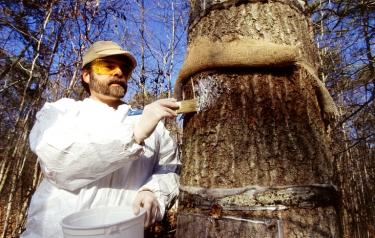When You Have an Outbreak
An entomologist raises a burlap trap to apply an insecticidal latex coating that will kill foraging gypsy moth larvae.
The first time gypsy moths come into an area, the outbreak can be serious for 10 to 20 years. But you aren’t helpless. Here are steps you can take to fight the hungry moths.
- Egg mass counts. Since Gypsy Moths lay eggs in the fall that don’t hatch until spring, you can get a pretty good idea of how severe the infestation might be by simply walking your woodlot and counting the number of egg masses on the trees. The higher the number of egg masses, the greater the probability of a severe infestation.
- Burlap trap. When the caterpillars are half-grown, many of them feed at night and crawl down the tree in the morning to seek shelter during the day. Take a 14- to 18-inch-wide piece of burlap or similar material. Wrap it around the tree at about chest height. Tie a piece of string around the center of the burlap band and fold the top portion down over the string. Larvae will take shelter under this apron. Check it daily and destroy all trapped larvae and pupae. This technique works best in light to moderate infestations from spring through mid-summer, or until males begin to fly.
- Insecticide. Several insecticides can help manage the gypsy moth. Apply insecticide according to the directions on the label after the majority of eggs have hatched, when larvae are small. (In the mid-Atlantic region, that's early to mid-May.) To maintain good plant health, insecticide should be applied before trees are seriously defoliated. In years of severe infestations, commercial aerial applications may be appropriate. When entering into a contract with a commercial applicator, be sure they list their pesticide applicator license number on the contract or receipt.
- Synthetic hormones. Synthetic hormones are available that disrupt the gypsy moths at different points in their life cycles. They can work by inhibiting molting, speeding up molting, or interfering with mating.
A local extension agent or forester can help you work out how to control gypsy moths on your land.
You can help keep the gypsy moth away from your woods in the first place or limit the gypsy moth’s impact by preparing for its arrival. Learn more with Your Checklist for Prevention.
Previous page
Next page
How can I get more tips?
It’s simple! Enter your email below.

